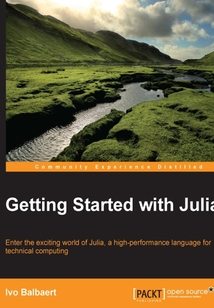目錄(110章)
倒序
- coverpage
- Getting Started with Julia
- Credits
- About the Author
- About the Reviewers
- www.PacktPub.com
- Support files eBooks discount offers and more
- Preface
- What this book covers
- What you need for this book
- Who this book is for
- Conventions
- Reader feedback
- Customer support
- The Rationale for Julia
- The scope of Julia
- Julia's place among the other programming languages
- A comparison with other languages for the data scientist
- Useful links
- Summary
- Chapter 1. Installing the Julia Platform
- Installing Julia
- Working with Julia's shell
- Startup options and Julia scripts
- Packages
- Installing and working with Julia Studio
- Installing and working with IJulia
- Installing Sublime-IJulia
- Installing Juno
- Other editors and IDEs
- How Julia works
- Summary
- Chapter 2. Variables Types and Operations
- Variables naming conventions and comments
- Types
- Integers
- Floating point numbers
- Elementary mathematical functions and operations
- Rational and complex numbers
- Characters
- Strings
- Regular expressions
- Ranges and arrays
- Dates and times
- Scope and constants
- Summary
- Chapter 3. Functions
- Defining functions
- Optional and keyword arguments
- Anonymous functions
- First-class functions and closures
- Recursive functions
- Map filter and list comprehensions
- Generic functions and multiple dispatch
- Summary
- Chapter 4. Control Flow
- Conditional evaluation
- Repeated evaluation
- Exception handling
- Scope revisited
- Tasks
- Summary
- Chapter 5. Collection Types
- Matrices
- Tuples
- Dictionaries
- Sets
- Example project – word frequency
- Summary
- Chapter 6. More on Types Methods and Modules
- Type annotations and conversions
- The type hierarchy – subtypes and supertypes
- User-defined and composite types
- Types and collections – inner constructors
- Type unions
- Parametric types and methods
- Standard modules and paths
- Summary
- Chapter 7. Metaprogramming in Julia
- Expressions and symbols
- Eval and interpolation
- Defining macros
- Built-in macros
- Reflection capabilities
- Summary
- Chapter 8. I/O Networking and Parallel Computing
- Basic input and output
- Working with files
- Using DataFrames
- Working with TCP sockets and servers
- Interacting with databases
- Parallel operations and computing
- Summary
- Chapter 9. Running External Programs
- Running shell commands
- Calling C and FORTRAN
- Calling Python
- Performance tips
- Summary
- Chapter 10. The Standard Library and Packages
- Digging deeper into the standard library
- Julia's package manager
- Publishing a package
- Graphics in Julia
- Using Gadfly on data
- Summary
- Appendix A. List of Macros and Packages
- Macros
- List of packages
- Index 更新時間:2021-07-23 20:34:25
推薦閱讀
- Learning Cython Programming(Second Edition)
- 少年輕松趣編程:用Scratch創(chuàng)作自己的小游戲
- 網(wǎng)頁設(shè)計與制作教程(HTML+CSS+JavaScript)(第2版)
- C語言程序設(shè)計立體化案例教程
- Reactive Programming With Java 9
- Easy Web Development with WaveMaker
- SharePoint Development with the SharePoint Framework
- Hands-On Natural Language Processing with Python
- Clojure Reactive Programming
- Qt5 C++ GUI Programming Cookbook
- Kotlin極簡教程
- Machine Learning for Developers
- Java EE架構(gòu)設(shè)計與開發(fā)實踐
- Python程序設(shè)計教程
- 大話C語言
- 編譯原理學(xué)習(xí)與實踐指導(dǎo)
- Real-time Analytics with Storm and Cassandra
- 數(shù)據(jù)可視化實戰(zhàn):使用D3設(shè)計交互式圖表(第2版)
- CAE分析大系:ABAQUS有限元分析從入門到精通
- 你好,C語言
- Python網(wǎng)絡(luò)爬蟲與數(shù)據(jù)分析從入門到實踐
- Mastering UI Development with Unity
- Web前端工程師修煉之道(原書第5版)
- SQL Server 2017 Integration Services Cookbook
- 跟老齊學(xué)Python:Django實戰(zhàn)(第2版)
- 敏捷開發(fā)一千零一夜
- Vagrant開發(fā)運維實戰(zhàn)
- MATLAB小波分析超級學(xué)習(xí)手冊
- Kali Linux 2:Windows Penetration Testing
- 數(shù)據(jù)庫應(yīng)用基礎(chǔ)(Access 2010)


